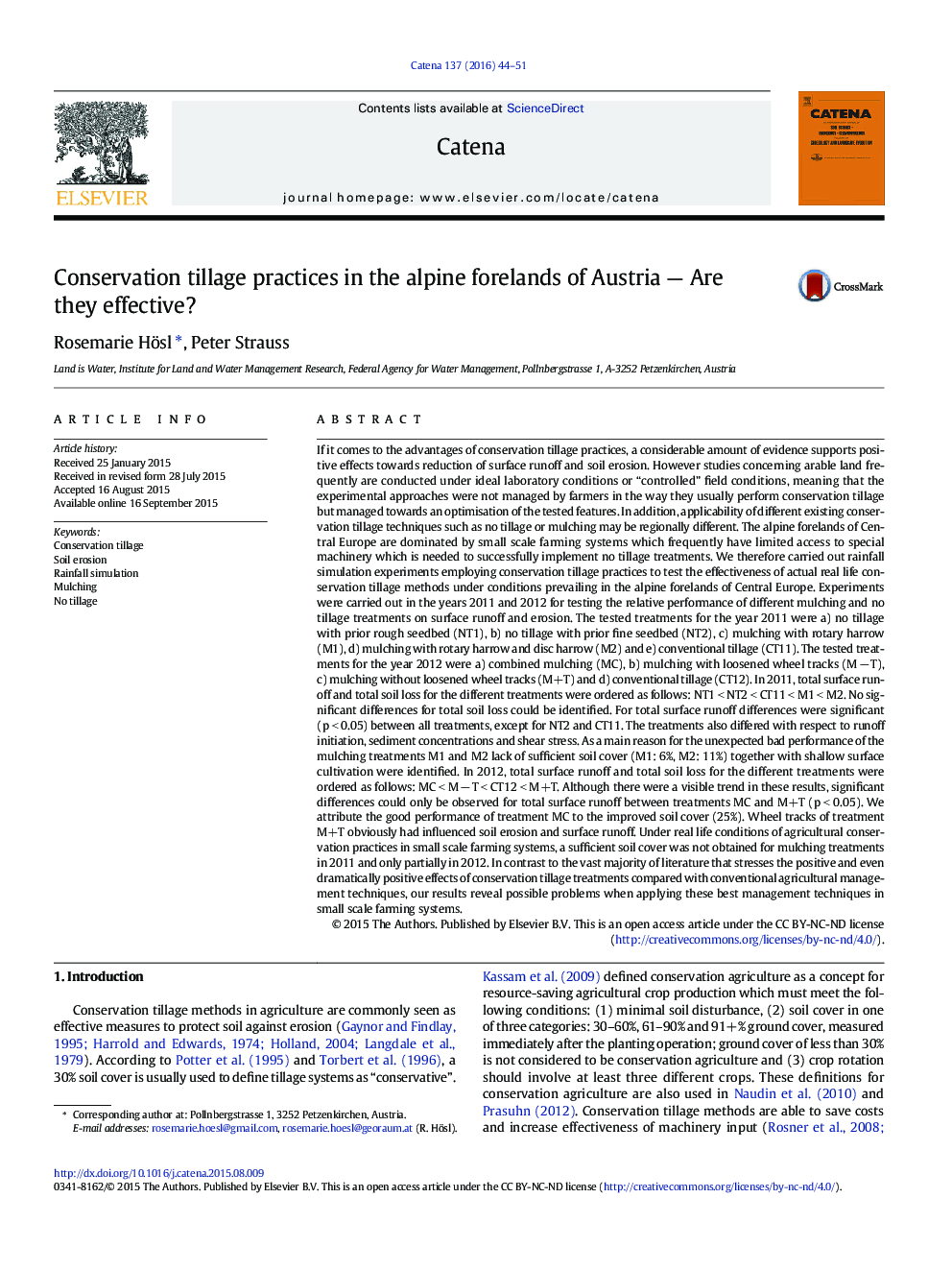| کد مقاله | کد نشریه | سال انتشار | مقاله انگلیسی | نسخه تمام متن |
|---|---|---|---|---|
| 6407924 | 1629215 | 2016 | 8 صفحه PDF | دانلود رایگان |
- Different conservation tillage methods were evaluated using rainfall simulation.
- Experiments were prepared according to real life context of conservation agriculture work in small scale farming systems.
- Crucial parameter for management success against erosion proved to be soil cover.
- Treatments including wheel tracks exhibited highest soil loss rates.
If it comes to the advantages of conservation tillage practices, a considerable amount of evidence supports positive effects towards reduction of surface runoff and soil erosion. However studies concerning arable land frequently are conducted under ideal laboratory conditions or “controlled” field conditions, meaning that the experimental approaches were not managed by farmers in the way they usually perform conservation tillage but managed towards an optimisation of the tested features. In addition, applicability of different existing conservation tillage techniques such as no tillage or mulching may be regionally different. The alpine forelands of Central Europe are dominated by small scale farming systems which frequently have limited access to special machinery which is needed to successfully implement no tillage treatments. We therefore carried out rainfall simulation experiments employing conservation tillage practices to test the effectiveness of actual real life conservation tillage methods under conditions prevailing in the alpine forelands of Central Europe. Experiments were carried out in the years 2011 and 2012 for testing the relative performance of different mulching and no tillage treatments on surface runoff and erosion. The tested treatments for the year 2011 were a) no tillage with prior rough seedbed (NT1), b) no tillage with prior fine seedbed (NT2), c) mulching with rotary harrow (M1), d) mulching with rotary harrow and disc harrow (M2) and e) conventional tillage (CT11). The tested treatments for the year 2012 were a) combined mulching (MC), b) mulching with loosened wheel tracks (M â T), c) mulching without loosened wheel tracks (M+T) and d) conventional tillage (CT12). In 2011, total surface runoff and total soil loss for the different treatments were ordered as follows: NT1 < NT2 < CT11 < M1 < M2. No significant differences for total soil loss could be identified. For total surface runoff differences were significant (p < 0.05) between all treatments, except for NT2 and CT11. The treatments also differed with respect to runoff initiation, sediment concentrations and shear stress. As a main reason for the unexpected bad performance of the mulching treatments M1 and M2 lack of sufficient soil cover (M1: 6%, M2: 11%) together with shallow surface cultivation were identified. In 2012, total surface runoff and total soil loss for the different treatments were ordered as follows: MC < M â T < CT12 < M+T. Although there were a visible trend in these results, significant differences could only be observed for total surface runoff between treatments MC and M+T (p < 0.05). We attribute the good performance of treatment MC to the improved soil cover (25%). Wheel tracks of treatment M+T obviously had influenced soil erosion and surface runoff. Under real life conditions of agricultural conservation practices in small scale farming systems, a sufficient soil cover was not obtained for mulching treatments in 2011 and only partially in 2012. In contrast to the vast majority of literature that stresses the positive and even dramatically positive effects of conservation tillage treatments compared with conventional agricultural management techniques, our results reveal possible problems when applying these best management techniques in small scale farming systems.
Journal: CATENA - Volume 137, February 2016, Pages 44-51
